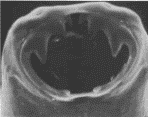
Could Parasites Be Troubling You?
National Geographic has called human waste “a sinister world of monstrous creatures that feed on living flesh : Parasites".
In fact it is estimated that 90% of the population has at least one form of parasite in the body. Once a person is infected it is not too difficult to eliminate the adult parasites. The more difficult part is dealing with the life cycle of the parasite which can take a considerable amount of time to accomplish.
Parasites may be present in food or in water and can cause disease. Ranging in size from tiny, single-celled organisms to worms visible to the naked eye, parasites are more and more frequently being identified as causes of food-borne illness not only in third world countries, but Western countries as well. The illnesses they can cause range from mild discomfort to debilitating illness and possibly death. It has been reported that 90% of the world population has at least one form of parasite living in their body! They live and feed off the host. They can deprive us of vitamins, nutrients and amino acids, alter our natural pH levels, decrease our energy levels and create an acidic environment in the body. Paratrex also aids the body in creating an in-hospitable environment for invading organisms.

What are parasites? Parasites are organisms that derive nourishment and protection from other living organisms known as hosts. They may be transmitted from animals to humans, from humans to humans, or from humans to animals. Several parasites have emerged as significant causes of food-borne and waterborne disease. These organisms live and reproduce within the tissues and organs of infected human and animal hosts, and are often excreted in feces.
They may be transmitted from host to host through consumption of contaminated food and water, or by putting anything into your mouth that has touched the stool (feces) of an infected person or animal.
Parasites are of different types and range in size from tiny, single-celled, microscopic organisms (protozoa) to larger, multi-cellular worms (Helminths) that may be seen without a microscope.
Some common parasites are Giardia duodenalis, Cryptosporidium parvum, Cyclospora cayetanensis, Toxoplasma gondii, Trichinella spiralis, Taenia saginata (beef tapeworm), and Taenia solium (pork tapeworm).

It is estimated that 90% of the population has at least one form of parasite in the body. Parasites include ringworm, roundworms, tapeworms, microbial growth and their eggs. There are many ways in which parasites can enter the body: through food that has not been properly washed, infected meat, water, pets, dirt under fingernails, and also through the skin (Hookworm). Once the infection of parasites takes place they begin to multiply rapidly. One of the most common symptoms of parasites is fatigue as a result of the parasites feeding upon the host—YOU! They can steal vital nutrients from the body which can result in compromised health and a compromised immune system.
“Every living thing has at least one parasite that lives inside or on it, and many, including humans, have far more. …Scientists…are only just beginning to discover exactly how powerful these hidden inhabitants can be, but their research is pointing to a remarkable possibility: Parasites may rule the world. The notion that tiny creatures we've largely taken for granted are such a dominant force is immensely disturbing. … We are collections of cells that work together, kept harmonized by chemical signals. If an organism can control those signals — an organism like a parasite — then it can control us. And therein lies the peculiar and precise horror of parasites.”

The typical life cycle of a parasite starts with ingestion of eggs by the host. Parasites typically like a warm, dark and moist environment. They hatch and then invade the intestinal wall. Some will migrate to other parts of the body and some will migrate to the anal part of the body. Some adult parasites can live in the host body for up to two years. During this time as many as 50,000 eggs may be deposited. While in the body the parasites feed off of ingested food and even nutritional supplements. They also have an elimination process which means that they actually “go to the bathroom” in the host body.
Once a person is infected it is not too difficult to eliminate the adult parasites. The more difficult part is dealing with the life cycle of the parasite which can take a considerable amount of time to accomplish.
|
|
If you have 3 or less of the above symptoms your health risk is medium.
If you have 4-7 of the above symptoms your health risk is high.
If you have 7 or more of the above symptoms your health risk extremely high.
